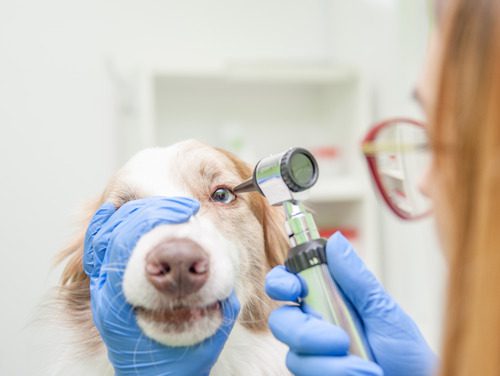Dog Eye Infections: When To Seek Emergency Care
Your dog’s eyes can tell you a lot—about how they’re feeling, what’s caught their attention, or when something’s not right. One moment your pet is chasing a ball, and the next, they’re squinting or pawing at their eye. It’s easy to overlook subtle changes, especially when symptoms come on slowly. But eye infections in dogs can progress quickly, and in some cases, require immediate veterinary attention. Below, we’ll review the warning signs and when you should call an emergency vet, so you can protect your dog’s eyesight and comfort.

What Causes Dog Eye Infections?
Several different sources can lead to dog eye infections, and the cause often guides how quickly a condition might become serious.
Bacterial or Viral Infections
Most dog eye infections stem from bacteria or viruses. These can develop after exposure to contaminated environments, other animals, or even from trauma to the eye that breaks the protective surface. In some cases, an upper respiratory infection may also contribute to eye discharge and inflammation.
Foreign Bodies or Eye Trauma
Debris, dust, grass seeds, or even a small scratch can introduce bacteria and irritate the eye. Dogs who enjoy digging or playing in wooded areas may be more prone to this type of infection. Even a brief exposure can result in redness, discharge, or excessive blinking.
Underlying Health Conditions
Conditions like dry eye (keratoconjunctivitis sicca), allergies, or autoimmune diseases can lead to recurring or chronic infections. These types of infections may not seem urgent at first but can quickly worsen without proper care, especially if they affect the cornea or reduce tear production.
What Are Common Signs of Dog Eye Infections?
Spotting a dog eye infection early can help prevent complications. While symptoms may vary based on the underlying cause, there are several signs pet owners should never ignore.
Redness and Swelling
One of the earliest indicators of a dog eye infection is redness. The tissue around the eye—particularly the conjunctiva—may appear irritated or inflamed. Swelling of the eyelids or the area around the eye can also occur and may signal an advancing infection.
Discharge or Crusting
Discharge may be clear, yellow, green, or even blood-tinged, depending on the infection. Crusting around the eyes in the morning or after naps is also common. Excessive tearing or mucus buildup should prompt a veterinary exam.
Squinting, Pawing, or Light Sensitivity
Dogs often react to eye discomfort by squinting, blinking rapidly, or avoiding light. You may also notice them pawing at their eyes or rubbing their face on the floor. These behaviors suggest irritation and are strong indicators that something more serious may be going on.
Cloudiness or Visible Changes in the Eye
Infections that go untreated may start to affect the cornea. Cloudiness or a bluish tint to the eye can mean that the infection has caused swelling or ulceration. Visible spots, blood vessels, or a film across the surface of the eye are concerning signs that require immediate evaluation.
When Dog Eye Infections Become an Emergency
Some dog eye infections progress quickly and need urgent attention to prevent permanent damage or even vision loss.
Sudden Swelling or Protrusion of the Eye
If your dog’s eye appears to bulge or protrude, or if the tissue around the eye is extremely swollen, seek emergency care. These symptoms can indicate trauma, glaucoma, or an abscess behind the eye—each of which can escalate quickly.
Corneal Ulcers or Surface Damage
A corneal ulcer is a break in the surface of the eye that can result from trauma, dry eye, or advanced infection. These ulcers can deepen and cause permanent scarring or rupture. If your dog is blinking rapidly, has a visible spot on the eye, or appears to be in pain, prompt care is critical.
Change in Vision or Behavior
If your dog begins bumping into objects, hesitating in familiar areas, or acting disoriented, an eye infection may have progressed to the point of affecting their vision. These symptoms always warrant immediate evaluation at a 24-hour emergency veterinary hospital.
Diagnosing Dog Eye Infections at the Emergency Vet
When your dog arrives at an emergency facility like The Village Vets – 24 Hour Emergency, the team will begin with a thorough eye exam to assess the extent and cause of the infection.
Eye Staining and Tear Testing
Fluorescein staining helps detect corneal ulcers or scratches by highlighting damaged areas. Tear production tests are used to check for dry eye, which can increase the risk of infection and impact healing.
Measuring Eye Pressure
In cases where swelling or discomfort is present, your vet may measure intraocular pressure to rule out glaucoma or other internal eye conditions. Glaucoma is painful and can lead to blindness if not treated quickly.
Sample Collection and Microscopy
If the infection appears severe or unusual, a sample of the discharge may be collected for microscopic evaluation. This can help identify specific bacteria or fungi, guiding the most effective treatment.
How Emergency Care Protects Your Dog’s Vision
Emergency treatment doesn’t just stop the infection—it helps prevent long-term damage to your dog’s eye health. Quick action supports faster healing and protects your pet’s comfort.
Targeted Medications
Based on the type and severity of infection, your veterinarian may prescribe antibiotic or antifungal eye drops, oral medications, or pain relievers. Administering the right treatment early can reduce inflammation and speed recovery.
Preventing Complications
Without emergency care, eye infections can lead to scarring, chronic inflammation, or even rupture of the eye in extreme cases. Treating the infection before it advances protects both your dog’s vision and quality of life.
What to Do If You Suspect an Eye Infection in Your Dog
If you notice any of the symptoms listed—especially redness, discharge, or signs of pain—it’s important to act quickly. Avoid trying to treat the infection at home, as over-the-counter drops or ointments may worsen the condition. Call The Village Vets – 24 Hour Emergency in Atlanta at (404) 371-9774 right away. Our emergency team is available around the clock to assess your dog’s eyes and provide the care they need.

